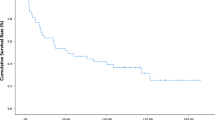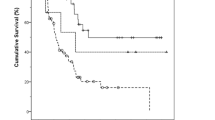Abstract
The purpose of this study was to investigate the prognostic factors of carcinoma of the ampulla of Vater (CAV) after surgery. The clinicopathological factors related to the recurrence and prognosis of 162 CAV patients after surgical resection were retrospectively analyzed using univariate and multivariate methods. The in-hospital mortality rate was 4.32 % and the 5-year disease-free survival and overall survival of the 162 subjects were 55.1 and 51.7 %, respectively. Univariate analysis revealed that an advanced T stage (P = 0.002), lymph nodal metastasis (P = 0.002), poor differentiation (P = 0.006), tumor size (P = 0.033), tumor stage (P = 0.001), carbohydrate antigen (CA) 199 serum levels (P = 0.000), pancreatic invasion (P = 0.001), chemotherapy/radiation therapy (P = 0.006), and jaundice (P = 0.012) were factors that significantly affected the prognosis of CAV. Multivariate analysis showed that the pancreatic invasion (P = 0.009), lymph nodal metastasis (P = 0.009), and increased CA199 serum level (P = 0.001) were independent risk factors of recurrence. The pancreatic invasion, lymph nodal metastasis, and increased CA199 serum level are key prognostic factors of CAV after surgery.

Similar content being viewed by others
References
Neugut AI, Jacobson JS, Rella VA. Prevalence and incidence of colorectal adenomas and cancer in asymptomatic persons. Gastrointest Endosc Clin N Am. 1997;7:387–99.
Barauskas G, Gulbinas A, Pranys D, et al. Tumor-related factors and patient’s age influence survival after resection for ampullary adenocarcinoma. J Hepatobiliary Pancreat Surg. 2008;15:423–8.
Al Ustwani O, Iancu D, Yacoub R, Iyer R. Detection of circulating tumor cells in cancers of biliary origin. J Gastrointest Oncol. 2012;3:97–104.
Pantel K, Alix-Panabières C. Detection methods of circulating tumor cells. J Thorac Dis. 2012;4:446–7.
O’Connell JB, Maggard MA, Manunga Jr J, et al. Survival after resection of ampullary carcinoma: a national population-based study. Ann Surg Oncol. 2008;15:1820–7.
Yoon YS, Kim SW, Park SJ, et al. Clinicopathologic analysis of early ampullary cancers with a focus on the feasibility of ampullectomy. Ann Surg. 2005;242:92–100.
Shiba H, Misawa T, Fujiwara Y, et al. Glasgow prognostic score predicts therapeutic outcome after pancreaticoduodenectomy for carcinoma of the ampulla of vater. Anticancer Res. 2013;33:2715–21.
Ma X, Zhang QY. Protein microarrays for quantitative detection of PAI-1 in serum. Chin J Cancer Res. 2012;24:220–5.
Ito K, Fujita N, Noda Y, et al. Diagnosis of ampullary cancer. Dig Surg. 2010;27:115–8.
Clary BM, Tyler DS, Dematos P, et al. Local ampullary resection with careful intraoperative frozen section evaluation for presumed benign ampullary neoplasms. Surgery. 2000;127:628–33.
Heinrich S, Clavien PA. Ampullary cancer. Curr Opin Gastroenterol. 2010;26:280–5.
Demetriades H, Zacharakis E, Kirou I, et al. Local excision as a treatment for tumors of ampulla of Vater. World J Surg Oncol. 2006;4:14.
Lee SY, Jang KT, Lee KT, et al. Can endoscopic resection be applied for early stage ampulla of Vater cancer? Gastrointest Endosc. 2006;63:783–8.
Yoon SM, Kim MH, Kim MJ, et al. Focal early stage cancer in ampullary adenoma: surgery or endoscopic papillectomy? Gastrointest Endosc. 2007;66:701–7.
Dixon E, Vollmer Jr CM, Sahajpal A, et al. Transduodenal resection of peri-ampullary lesions. World J Surg. 2005;29:649–52.
Hatzaras I, George N, Muscarella P, et al. Predictors of survival in periampullary cancers following pancreaticoduodenectomy. Ann Surg Oncol. 2010;17:991–7.
Duffy JP, Hines OJ, Liu JH, et al. Improved survival for adenocarcinoma of the ampulla of Vater: fifty-five consecutive resections. Arch Surg. 2003;138:941–8.
de Paiva Haddad LB, Patzina RA, et al. Lymph node involvement and not the histopathologic subtype is correlated with outcome after resection of adenocarcinoma of the ampulla of vater. J Gastrointest Surg. 2010;14:719–28.
Qiao QL, Zhao YG, Ye ML, et al. Carcinoma of the ampulla of Vater: factors influencing long-term survival of 127 patients with resection. World J Surg. 2007;31:137–43.
Winter JM, Cameron JL, Olino K, et al. Clinicopathologic analysis of ampullary neoplasms in 450 patients: implications for surgical strategy and long-term prognosis. J Gastrointest Surg. 2010;14:379–87.
Riall TS, Cameron JL, Lillemoe KD, et al. Resected periampullary adenocarcinoma: 5-year survivors and their 6- to 10-year follow-up. Surgery. 2006;140:764–72.
Roland CL, Katz MH, Gonzalez GM, et al. A high positive lymph node ratio is associated with distant recurrence after surgical resection of ampullary carcinoma. J Gastrointest Surg. 2012;16:2056–63.
Sierzega M, Nowak K, Kulig J, et al. Lymph node involvement in ampullary cancer: the importance of the number, ratio, and location of metastatic nodes. J Surg Oncol. 2009;100(1):19–24.
Botsios D, Zacharakis E, Lambrou I, et al. Our local experience with the surgical treatment of ampullary cancer. Int Semin Surg Oncol. 2005;2:16.
Lee JH, Whittington R, Williams NN, et al. Outcome of pancreaticoduodenectomy and impact of adjuvant therapy for ampullary carcinomas. Int J Radiat Oncol Biol Phys. 2000;47:945–53.
Beger HG, Treitschke F, Gansauge F, et al. Tumor of the ampulla of Vater: experience with local or radical resection in 171 consecutively treated patients. Arch Surg. 1999;134:526–32.
Hsu HP, Yang TM, Hsieh YH, et al. Predictors for patterns of failure after pancreaticoduodenectomy in ampullary cancer. Ann Surg Oncol. 2007;14:50–60.
Zhou G, Chiu D, Qin D, et al. The efficacy evaluation of cryosurgery in pancreatic cancer patients with the expression of CD44v6, integrin-β1, CA199, and CEA. Mol Biotechnol. 2012;52:59–67.
Zhou G, Niu L, Chiu D, et al. Changes in the expression of serum markers CA242, CA199, CA125, CEA, TNF-α and TSGF after cryosurgery in pancreatic cancer patients. Biotechnol Lett. 2012;34:1235–41.
Zhou J, Hsu CC, Winter JM, et al. Adjuvant chemoradiation versus surgery alone for adenocarcinoma of the ampulla of Vater. Radiother Oncol. 2009;92:244–8.
Narang AK, Miller RC, Hsu CC, et al. Evaluation of adjuvant chemoradiation therapy for ampullary adenocarcinoma: the Johns Hopkins Hospital–Mayo Clinic collaborative study. Radiat Oncol. 2011;6:126.
Conflicts of interest
None
Author information
Authors and Affiliations
Corresponding author
Additional information
Jianguo Zhou and Qian Zhang equally contributed to this work.
Rights and permissions
About this article
Cite this article
Zhou, J., Zhang, Q., Li, P. et al. Prognostic factors of carcinoma of the ampulla of Vater after surgery. Tumor Biol. 35, 1143–1148 (2014). https://doi.org/10.1007/s13277-013-1153-9
Received:
Accepted:
Published:
Issue Date:
DOI: https://doi.org/10.1007/s13277-013-1153-9




